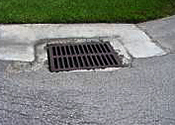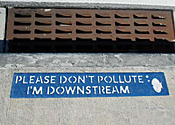
Many residents may not realize the importance of a stormwater drainage system, especially when it is operating efficiently.
Stormwater drainage systems include curbs, ditches, pipes, gutters, culverts and, of course, storm drains, all of which collect the stormwater runoff and carry it to its discharge point, away from roads and structures.

When working properly and without obstruction, the stormwater drainage system prevents flooding of roadways, buildings and parking lots.
Throughout the city there are different types of storm inlets. They all have the same purpose: to collect stormwater and direct it into a storm system that is underground. This storm system then transfers the runoff to a canal or lake, eventually leading to the river.

Whatever pollutants not removed in the process, either by settling in the canal or lake, or removed by the vegetation, will be deposited in our rivers. The City of Port St. Lucie has an ongoing water-quality testing program that samples the outfalls of our drainage canals into the North Fork of the St. Lucie River.


As a reminder not to dump pollutants down storm inlets, a stencil will be placed on the inlets throughout the city, with the illustration of a fish and the words "Please don't pollute, I'm downstream", "No Dumping Drains to Waterway".